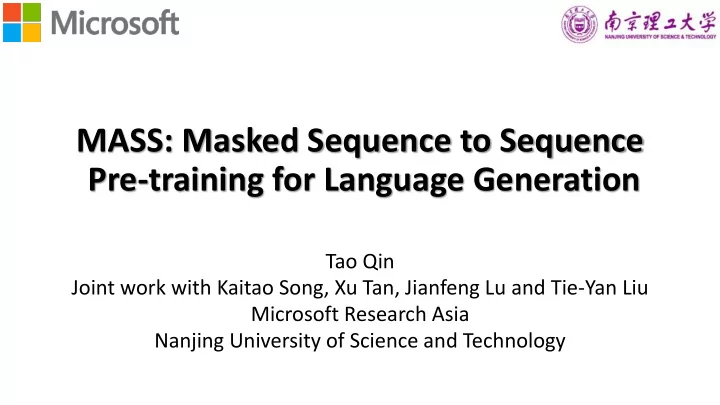

MASS: Masked Sequence to Sequence Pre-training for Language Generation Tao Qin Joint work with Kaitao Song, Xu Tan, Jianfeng Lu and Tie-Yan Liu Microsoft Research Asia Nanjing University of Science and Technology
Motivation • BERT and GPT are very successful • BERT pre-trains an encoder for language understanding tasks • GPT pre-trains a decoder for language modeling. • However, BERT and GPT are suboptimal on sequence to sequence based language generation tasks • BERT can only be used to pre-train encoder and decoder separately. • Encoder-to-decoder attention is very important, which BERT does not pre-train. Method BLEU Without attention 26.71 With attention 36.15 Bahdanau, Dzmitry, Kyunghyun Cho, and Yoshua Bengio. "Neural machine translation by jointly learning to align and translate." ICLR 2015.
MASS: Pre-train for Sequence to Sequence Generation • MASS is carefully designed to jointly pre-train the encoder and decoder K • Mask k consecutive tokens (segment) • Force the decoder to attend on the source representations, i.e., encoder-decoder attention • Force the encoder to extract meaningful information from the sentence • Develop the decoder with the ability of language modeling
MASS vs. BERT/GPT K=m K=m K=m K=1
Unsupervised NMT XLM: Cross-lingual language model pretraining, CoRR 2019
Low-resource NMT
Text summarization Gigaword Corpus
Analysis of MASS: length of masked segment (a), (b): PPL of the pre-trained model on En and Fr (c): BLEU score of unsupervised En-Fr (d): ROUGE of text summarization K=50%m is a good balance between encoder and decoder K=1 (BERT) and K=m (GPT) cannot achieve good performance in language generation tasks.
Summary • MASS jointly pre-trains the encoder-attention-decoder framework for sequence to sequence based language generation tasks • MASS achieves significant improvements over the baselines without pre- training or with other pre-training methods on zero/low-resource NMT, text summarization and conversational response generation.
Thanks !
Backup
MASS pre-training • Model configuration • Transformer, 6-6 layer, 1024 embedding. • Support cross-lingual tasks such as NMT, as well as monolingual tasks such as text summarization, conversational response generation. • English, German, French, Romanian, each language with a tag. • Datasets • We use monolingual corpus from WMT News Crawl. Wikipedia data is also feasible. • 190M, 65M, 270M, 2.9M for English, French, German, Romanian. • Pre-training details • K=50%m, 8 V100 GPUs, batch size 3000 tokens/gpu.
MASS (k=m) GPT
Analysis of MASS • Ablation study of MASS • Discrete: instead of masking continuous segment, masking discrete tokens • Feed: Feed the tokens to the decoder that appear in the encoder
Fine-tuning on conversation response generation • We fine-tune the model on the Cornell movie dialog corpus, and simply use PPL to measure the performance of response generation.
Analysis of MASS: length of masked segment (a), (b): PPL of the pre-trained model on En and Fr (c): BLEU score of unsupervised En-Fr (d), (e): ROUGE and PPL on text summarization and response generation K=50%m is a good balance between encoder and decoder K=1 (BERT) and K=m (GPT) cannot achieve good performance in language generation tasks.
Recommend
More recommend